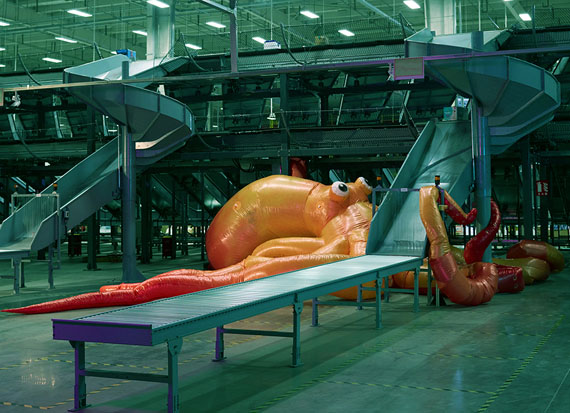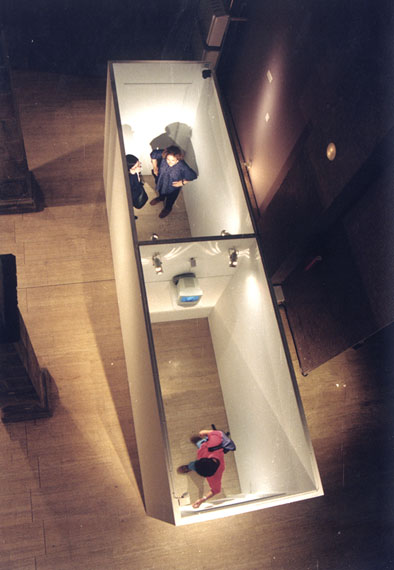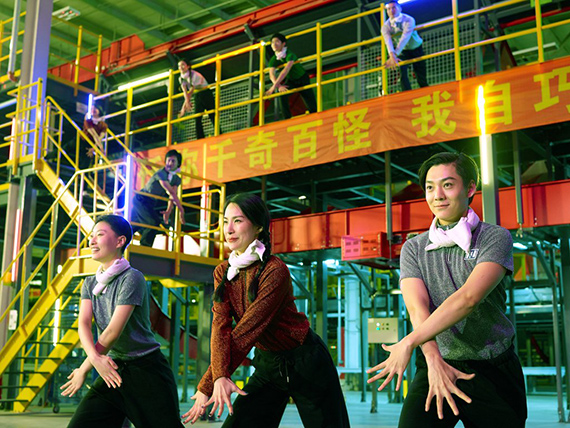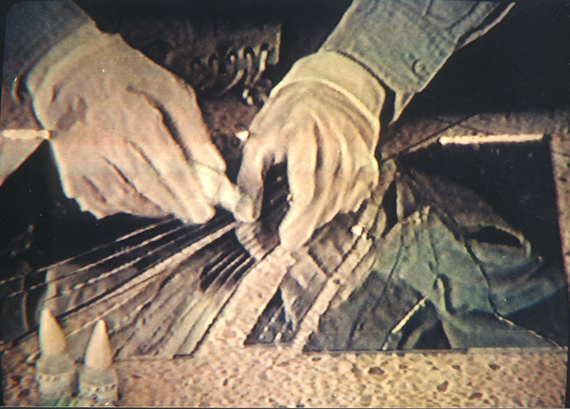
Delusional Mandala, 2015 (Video Still)
Multichannel video installation
© Lu Yang & Société
MICRO ERA
Media Art from China / MEDIENKUNST AUS CHINA
Fang Di » CAO Fei » ZHANG Peili » Lu Yang »
Exhibition: 5 Sep 2019 – 26 Jan 2020
Wed 4 Sep 19:00

Kulturforum am Potsdamer Platz
Matthäikirchplatz 4/6
10785 Berlin
+49 (0)30-2662188
presse@smb.spk-berlin.de
www.smb.museum/mf
Tue-Fri 10-18, Thu 10-20, Sat+Sun 11-18

The Magical of Pipes, 2019 (Video Still)
Zwei-Kanal-Videoinstallation, 30 Min.
Two-channel video installation, 30’
© Fang Di / Vannguard Gallery
"Micro Era"
Media Art from China
Exhibition: 5 September 2019 – 26 January 2020
Opening: Wednesday, 4 September, 7pm
A special exhibition of the Nationalgalerie – Staatliche Museen zu Berlin and the Gesellschaft für Deutsch-Chinesischen kulturellen Austausch e.V. (GeKA e.V. 德中文化交流基金会), on the occasion of the 25th anniversary of the city partnership Berlin-Beijing, funded by the Lotto Stiftung Berlin
In the frame of the 25th anniversary of the city partnership Berlin-Beijing Berlin’s Kulturforum will present the group exhibition "Micro Era. Media Art from China". The two artists Cao Fei (*1978) and Lu Yang (*1984) asked the artists Fang Di (*1987) and Zhang Peili (*1957) for a dialogue. The artists selected the works together with the Chinese and German curators Anna-Catharina Gebbers (Hamburger Bahnhof – Museum für Gegen-wart – Berlin), Victor Wang (freelance curator, Shanghai/London) and Yang Beichen (freelance curator and film reseacher, Beijing) accompanied by Pi Li (M +, Hong Kong) as curatorial advisor. The exhibition project was initiated by Yu Zhang 张 彧, president of the Gesellschaft für Deutsch-Chinesischen kulturellen Austausch e.V. (GeKA e.V. 德中文 化交流基金会).
"Micro Era" is tied in with the group exhibition living in time. 29 contemporary artists from China, which was presented in 2001 at the Hamburger Bahnhof – Museum für Gegenwart – Berlin. This exhibition already showed works of Cao Fei as well as Zhang Peili and was also devised by a Chinese-German team of curators, to which, amongst others, Pi Li also belonged. The exhibition showed how contemporary Chinese artists have responded to the economic, political, ideological but also technological changes in China since the 1980s. This approach is now continued with "Micro Era".
From documentary film images, and the adapted use of classical film lan-guage to the aesthetics of Japanese Anime, the works of this exhibition focus on and explore the relationships between mind, body and technology – with installations and single-channel videos ranging from the 1980s to the present. Historically, within the Euro-American context, video art is often regarded as a democratising art form – through the rapid circulation of information and global events by fast-access technologies. Cao Fei, Fang Di, Lu Yang, and Zhang Peili scrutinise the seductive thesis of this democratisation by reflecting in their visual language the mass production of goods as well as how images and virtual subjectivities are produced and consumed, and how we understand our world through imaging technology. At the same time, in the cross-generational exhibition with docu-mentary, narrative and installation references and the expansion into virtual space, the central directions in the development of media art in China are presented.
Cao Fei (*1978 in Guangzhou, lives in Beijing, China) combines in her films and installations social comments, pop-cultural aesthetics as well as references to surrealism and documentary film. Her works reflect the rapid, chaotic changes that are taking place in today's Chinese society. For "Micro Era" Cao Fei presents her works "Asia One" (2018) and "11.11" (2018) for the first time in Germany. The multimedia installation, which is about the logistics sector, conveys the hyper-real vision of a near future and shows the effects of accelerated economic growth, technological de-velopments and globalization on society. Cao Fei wished to see the young multimedia artist Fang Di as a dialogue partner on her exhibition area.
Fang Di's works (*1987 in Shenzhen, lives in Shenzhen, Guangdong, China) deal with issues of racism in a broader geopolitical context. By in-corporating film materials from news and documentaries, his works com-bine various visual languages in order to critically examine these inter-connections. In his first large-scale institutional presentation in Europe so far, Fang Di shows two multimedia-installations and one object. The three works "Minister" (2019), "Sepik River Ring" (2019) and "The Magical of Pipes" (2019) are based on Fang Di's work experience in Papua New Guinea for a Belt and Road Initiative company (which has been pooling China's interests and objectives to build up and expand intercontinental trade and infrastructure networks between the People's Republic of China and over 60 other African, Asian and European countries since 2013). His activities in the South Pacific Island Nation allowed him, analogous to embedded journalism, an intimate documentation of the current social situation.
Lu Yang (*1984 in Shanghai, lives in Shanghai, China) interweaves virtu-al and physical architectures in her installations. The artist lures the viewer into the hells of images of an augmented reality and manipulated emotions symbolically represented by transcranial magnetic stimulation. With knowledgeable references to traditional Buddhism, techno religions, cyber feminism and Japanese subcultures, her works circle around gender stereotypes, beliefs in science and post-human ways of life. For "Micro Era", Lu Yang has embedded the largest ever presentation of her works in an installation reminding us of the labyrinthine constructions of Comic Cons. She asked her former professor Zhang Peili for an exhibition dialogue.
Zhang Peili (*1957 in Hangzhou, lives in Hangzhou, China) is a pioneer of multimedia art and crucial to the development of the Chinese avant-garde and the emergence and spread of Chinese video art. His early work is often associated with the socio-political events that occurred during the heyday of the '85s New Wave movement, which led to the fact that the notions of xingwei yishu 行为艺术 (performance art) and yingxiang yishu 影像 艺术 (video art) were canonized in China. For "Micro Era", Zhang Peili presents pioneering video art pieces such as "30x30" (1988), "Document on Hygiene No. 3" (1991) and for the first time in Germany the installations "Uncertain Pleasure I" (1996) and "Opposite Space" (1995). The one-channel video work "30x30" (1988) is often referred to as the first video art work produced in China.
For the exhibition, Kerber Verlag publishes a publication with prefaces by Michael Müller, Governing Mayor of Berlin, Yu Zhang, and Udo Kittel-mann, as well as text contributions by Anna-Catharina Gebbers, Pi Li, Vic-tor Wang and Yang Beichen, 128 pages, 100 illustrations, German / English, ISBN 978-3-7356-0620-4, 30 €.
More information: www.smb.museum/microera

Asia One, 2018 (Video Still)
Single-Chanel Videoinstallaion, 63’
© Cao Fei & Sprüth Magers & Vitamin Creative
"Micro Era"
Medienkunst aus China
Ausstellung: 5. September 2019 bis 26. Januar 2020
Eröffnung: Mittwoch, 4. September, 19 Uhr
Eine Sonderausstellung der Nationalgalerie – Staatliche Museen zu Berlin und der Gesellschaft für Deutsch-Chinesischen kulturellen Austausch e.V. anlässlich des 25jährigen Jubiläums der Städtepartnerschaft Berlin-Peking, gefördert von der Lotto Stiftung Berlin
Anlässlich des 25jährigen Jubiläums der Städtepartnerschaft Berlin-Peking wird im Berliner Kulturforum die Gruppenausstellung "Micro Era. Medienkunst aus China" gezeigt, für die die beiden Künstlerinnen Cao Fei (*1978) und Lu Yang (*1984) die Künstler Fang Di (*1987) und Zhang Peili (*1957) zu einem Dialog baten. Initiiert wurde das Projekt von Yu Zhang 张彧, Präsidentin der Gesellschaft für Deutsch-Chinesischen Austausch e.V. (GeKA e.V. 德中文 化交流基金会). Die Ausstellung ist kuratiert von Anna-Catharina Gebbers mit den Co-Kuratoren Victor Wang und Yang Beichen und dem kuratorischen Berater Pi Li.
"Micro Era" knüpft an die Gruppenausstellung „living in time. 29 zeitgenössische Künstler aus China“ an, die 2001 im Hamburger Bahnhof – Museum für Gegenwart – Berlin präsentiert wurde. Bereits diese Ausstellung zeigte Werke von Cao Fei wie Zhang Peili und wurde ebenfalls von einem chinesisch-deutschen Kurator*innenteam erdacht, zu dem u.a. auch Pi Li gehörte. Die Ausstellung zeigte, wie zeitgenössische Künstler*innen aus China auf den ökonomischen, politischen, ideologischen, aber auch technologischen Wandel in China seit den 1980er-Jahren reagiert haben. Diesen Ansatz setzt "Micro Era" nun fort.
Von Dokumentarfilmbildern über die Auseinandersetzung mit klassischer Filmsprache bis zur Ästhetik des japanischen Anime konzentriert sich die Ausstellung auf das Verhältnis zwischen Geist, Körper und Technologie in Installationen und Videoarbeiten, die von den 1980er-Jahren bis in die Gegenwart reichen. Im Euro-Amerikanischen Kontext wird Videokunst historisch oft als demokratisierende Kunstform betrachtet. Denn durch die schnell zugängliche Technik ermöglichen Videos eine rasante Verbreitung von Informationen sowie globalen Ereignissen. Cao Fei, Fang Di, Lu Yang und Zhang Peili hinterfragen die verführerische These von dieser Demokratisierung, indem sie in ihrer Bildsprache ebenso die Massenproduktion von Waren reflektieren, wie die Art und Weise wie Bilder produziert und konsumiert werden oder wie wir unsere Welt durch bildgebende Technologien verstehen. Zugleich bilden sich in der generationenübergreifenden Ausstellung mit dokumentarischen, narrativen wie installativen Bezügen und der Erweiterung in den virtuellen Raum die zentralen Richtungen in der Entwicklung der Medienkunst in China ab.
Cao Fei (*1978 in Guangzhou, lebt in Peking, China) verbindet in ihren Filmen und Installationen soziale Kommentare, popkulturelle Ästhetik, sowie Bezüge zum Surrealismus und Dokumentarfilm. Ihre Werke reflektieren die rasanten, chaotischen Veränderungen, die sich in der heutigen chinesischen Gesellschaft vollziehen. Für „Micro Era“ präsentiert Cao Fei ihre Werke "Asia One" (2018) und "11.11" (2018) erstmals in Deutschland. Die um den Logistiksektor kreisende Multimediainstallation vermittelt die hyperreale Vision einer nahen Zukunft und zeigt die Auswirkungen von beschleunigtem Wirtschaftswachstum, technologischen Entwicklungen und der Globalisierung auf die Gesellschaft. Als Dialogpartner auf ihrer Ausstellungsfläche wünschte sich Cao Fei den jungen Multimediakünstler Fang Di.
Die Arbeiten von Fang Di (*1987 in Shenzhen, lebt in Shenzhen, Guangdong, China) drehen sich um Fragen des Rassismus in einem breiteren geopolitischen Kontext. Durch das Einbeziehen von Filmmaterialien aus Nachrichten und Dokumentationen verbinden seine Arbeiten verschiedene visuelle Sprachen, um diese Verflechtungen kritisch zu untersuchen. In seiner bislang ersten großen institutionellen Präsentation in Europa zeigt Fang Di zwei Multimediainstallationen und ein Objekt. Die drei Werke "Minister" (2019), "Sepik River Ring" (2019) und "The Magical of Pipes" (2019) basieren auf Fang Dis Arbeitserfahrung in Papua-Neuguinea für ein Unternehmen der Belt and Road Initiative; diese bündelt seit 2013 die Interessen und Ziele Chinas zum Auf- und Ausbau interkontinentaler Handels- und Infrastruktur-Netze zwischen der Volksrepublik China und über 60 weiteren Ländern Afrikas, Asiens und Europas. Seine Tätigkeit in der südpazifischen Inselnation erlaubte ihm analog zum Embedded Journalism eine intime Dokumentation der aktuellen gesellschaftlichen Situation.
Lu Yang (*1984 in Schanghai, lebt in Schanghai, China) verwebt in ihren Installationen virtuelle mit physischen Architekturen. Die Künstlerin lockt den Betrachtern in Bilder-Höllen einer erweiterten Realität und manipulierter Emotionen, für die symbolisch etwa die transkranielle Magnetstimulation steht. Mit kenntnisreichen Bezügen zu traditionellem Buddhismus, Technoreligionen, Cyberfeminismus und japanischen Subkulturen kreisen ihre Werke um Genderrollenklischees, Wissenschaftsglaube und posthu-mane Lebensformen. Für "Micro Era" hat Lu Yang die bislang größte Prä-sentation ihrer Werke überhaupt in eine Installation eingebettet, die an die labyrinthischen Aufbauten von Comic Cons erinnern. Sie bat ihren ehemaligen Professor Zhang Peili zu einem Ausstellungsdialog.
Zhang Peili (*1957 in Hangzhou, lebt in Hangzhou, China) ist ein Pionier der Multimedia-Kunst und entscheidend für die Entwicklung der chinesi-schen Avantgarde und der Entstehung und Verbreitung der chinesischen Videokunst. Seine frühen Arbeiten werden häufig in den Zusammenhang mit den sozial-politischen Ereignissen während des Höhepunkts der 85er-New-Wave-Bewegung gebracht, die dazu führten, dass die Begriffe xing-wei yishu 行为艺术 (Performance Art) und yingxiang yishu 影像 艺术 (Vi-deo Art) in China kanonisiert wurden. Für "Micro Era" präsentiert Zhang Peili wegweisende Videokunstwerke wie "30x30" (1988), "Document on Hygiene No. 3" (1991) und erstmals in Deutschland die Installationen "Uncertain Pleasure I" (1996) und "Opposite Space" (1995). Die einkanalige Videoarbeit "30x30" (1988) wird oft als das erste in China produzierte Videokunstwerk bezeichnet.
Zur Ausstellung erscheint im Kerber Verlag eine Publikation mit Vorworten von Michael Müller, Regierender Bürgermeister von Berlin, Yu Zhang und Udo Kittelmann, sowie mit Textbeiträgen von Anna-Catharina Gebbers, Pi Li, Victor Wang und Yang Beichen, 128 Seiten, 100 Abbildungen, Deutsch / Englisch, ISBN 978-3-7356-0620-4, Preis: 30 €.
Weitere Informationen: www.smb.museum/microera

Opposite Space, 1995
Two channel video installation with surveillance cameras and TV displays
Installlationview: China Artisctic Avantgarde Movements, Centre d’Art Santa Monica, Barcelona, 1995
© Zhang Peili & Boers-Li Gallery

Asia One, 2018 (Video Still)
Single-Chanel Videoinstallaion, 63’
© Cao Fei & Sprüth Magers & Vitamin Creative

Asia One, 2018 (Video Still)
Single-Chanel Videoinstallaion, 63’
© Cao Fei & Sprüth Magers & Vitamin Creative
